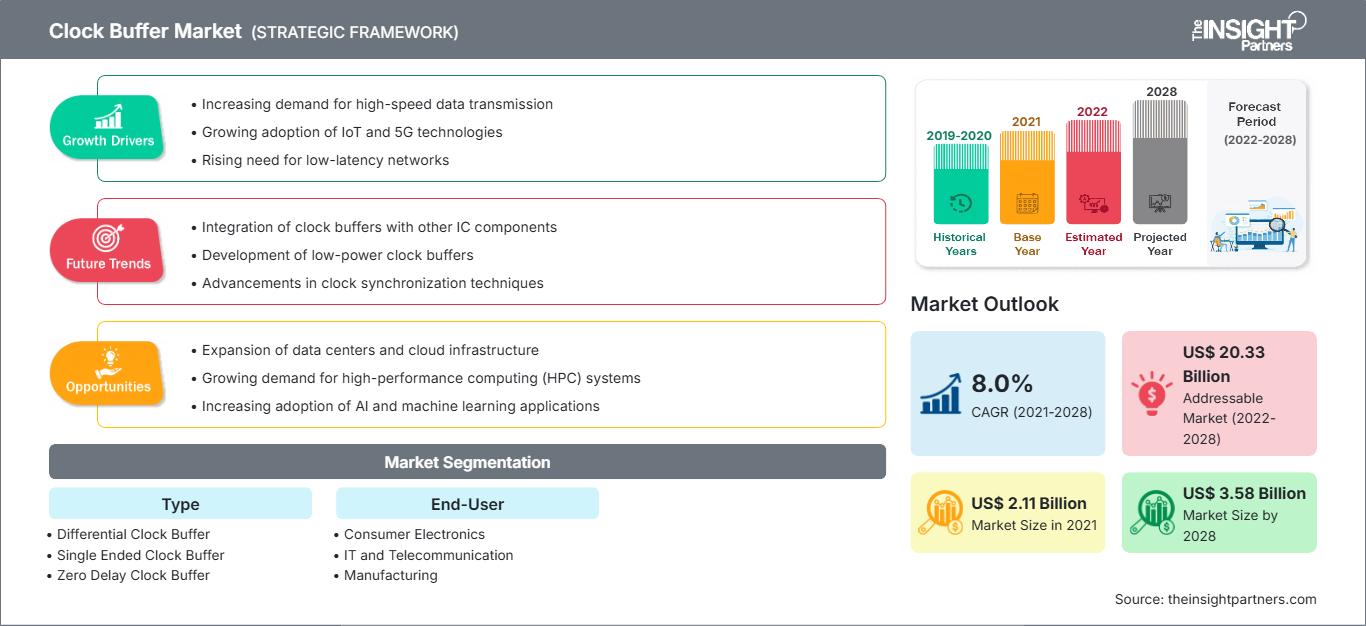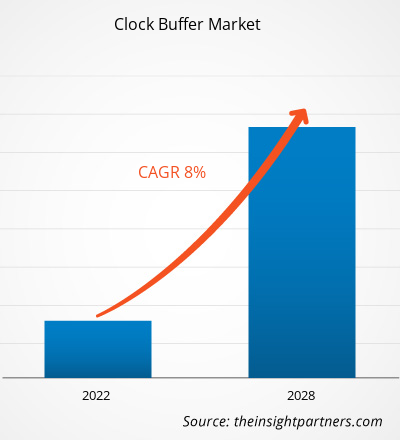Le marché des tampons d'horloge devrait atteindre 3 579,91 millions de dollars américains d'ici 2028, contre 2 112,53 millions de dollars américains en 2021 ; sa croissance devrait atteindre un TCAC de 8,0 % de 2022 à 2028.
Le marché mondial des tampons d'horloge, basé sur la géographie, est segmenté en Amérique du Nord, Europe, Asie-Pacifique, Moyen-Orient et Afrique, et Amérique du Sud. En 2021, l'Amérique du Nord était en tête de l'analyse du marché des tampons d'horloge avec une part de 40,5 %, suivie de l'Asie-Pacifique et de l'Europe. Ces dernières années, la demande en cloud computing a connu une croissance significative, ce qui a stimulé la pénétration d'Internet. Par conséquent, de nombreux IDE investissent massivement en Amérique du Nord, ce qui a un impact positif sur le cloud computing. Le gouvernement américain a pris de nombreuses initiatives pour stimuler l'industrie de l'électronique grand public. Par exemple, le 6 mai 2022, le gouvernement américain a présenté une nouvelle proposition bipartite visant à dynamiser le secteur des circuits imprimés (PCB) du pays. De nombreuses entreprises établies du secteur de la fabrication électronique aux États-Unis ont accueilli favorablement cette proposition. Ce projet de loi viendra appuyer la loi CHIPS de 2021 et la loi américaine sur les circuits imprimés de 2022. Par conséquent, les principaux acteurs du marché nord-américain des tampons d'horloge bénéficieront d'opportunités lucratives dans les années à venir. Le marché des tampons d'horloge en Asie-Pacifique est segmenté en Inde, en Chine, au Japon, en Australie et dans le reste de la région. En raison de la crise de la COVID-19, de nombreux gouvernements de la région ont été contraints de revoir leurs méthodes d'achat d'appareils mis à niveau, tels que des ordinateurs de bureau, des ordinateurs portables et des ordinateurs personnels, ainsi que des équipements de serveurs à usage général auprès de fournisseurs et de fabricants désignés. Par conséquent, la demande pour d'autres systèmes de communication, tels que les routeurs, les modems, les systèmes électroniques filaires et sans fil (panneaux) et autres périphériques, est en hausse, ce qui a créé de nombreuses opportunités lucratives pour les principaux fournisseurs exploitant ce marché. En Inde, les fournisseurs de services et de solutions d'information, de communication et de technologie ont adapté leurs modèles économiques au télétravail en raison de la crise de la COVID-19. De plus, les écoles et les universités ont continué à fonctionner à distance en 2022, rendant le besoin d'un ordinateur essentiel pour les étudiants. Certains étudiants qui utilisaient auparavant des smartphones ou des tablettes pour les cours virtuels sont passés aux PC, car ils offrent des avantages tels que des écrans plus grands et une plus grande facilité d'utilisation, ce qui a eu un impact positif sur le marché des mémoires tampons.
Vous bénéficierez d’une personnalisation sur n’importe quel rapport - gratuitement - y compris des parties de ce rapport, ou une analyse au niveau du pays, un pack de données Excel, ainsi que de profiter d’offres exceptionnelles et de réductions pour les start-ups et les universités
Marché tampon de l'horloge: Perspectives stratégiques

- Obtenez les principales tendances clés du marché de ce rapport.Cet échantillon GRATUIT comprendra une analyse de données, allant des tendances du marché aux estimations et prévisions.
Impact de la pandémie de COVID-19 sur le marché des tampons d'horloge
Grâce aux politiques gouvernementales favorables visant à stimuler l'innovation et à renforcer les capacités des infrastructures, l'Amérique du Nord présente le taux d'acceptation et de développement des technologies émergentes le plus élevé. Selon le rapport 2020 de CBRE sur les tendances des centres de données en Amérique du Nord, le secteur des centres de données de la région a été dynamique au premier semestre 2020 grâce à la mise en œuvre d'infrastructures informatiques hybrides par les organisations pour développer les capacités de travail à distance. La pandémie de COVID-19 en Amérique du Nord a contraint les entreprises à mettre en œuvre une stratégie de travail à domicile (WFH) pour poursuivre leurs processus opérationnels pendant la crise, ce qui a stimulé la demande en big data et en analyse de données. En 2020, les entreprises ont exploré les applications d'IA et l'analyse de big data pour fournir des informations aux utilisateurs afin de planifier l'utilisation des ressources pour des défis spécifiques en sciences médicales et ont proposé un modèle de santé basé sur l'IA et l'analyse de big data. Cependant, à partir du premier trimestre 2021, les chaînes d'approvisionnement des secteurs automobile et électronique ont commencé à se stabiliser, et les revenus de ces secteurs ont affiché une dynamique positive, ce qui a ensuite propulsé la croissance du marché des horloges tampons en Amérique du Nord.
Analyses du marché – Marché des horloges tampons
Le marché européen des horloges tampons est segmenté en France, en Allemagne, en Russie, au Royaume-Uni et dans le reste de l'Europe. L'émergence d'appareils électroménagers intelligents, tels que les machines à laver, les climatiseurs, les caméras de sécurité et les fours à micro-ondes, contribue également à la croissance du marché des horloges tampons. Les consommateurs européens ont amélioré leur niveau de vie. De plus, la pénétration croissante du Wi-Fi et du Bluetooth a entraîné l'achat d'appareils électroménagers. Ainsi, la demande d'appareils intelligents est élevée. Le thermostat Google Nest, le dernier appareil électroménager intelligent, utilise une application pour smartphone qui contrôle le système CVC. Lorsqu'un utilisateur s'en approche, l'appareil se réveille et active l'écran. La demande de tampons d'horloge augmentera avec la croissance de l'électronique grand public.
Informations basées sur le type
Selon le type, le marché des tampons d'horloge est segmenté en tampons d'horloge différentiels, tampons d'horloge zéro et tampons d'horloge asymétriques. Les tampons de sortie asymétriques peuvent avoir des entrées asymétriques ou différentielles. Les tampons d'horloge de sortie asymétriques sont des LVCMOS, tandis que les tampons de sortie différentiels peuvent être des LVPECL, HSTL ou LVDS (Low Voltage Differential Signaling).
Le marché est segmenté en fonction du type, de l'utilisateur final et de la géographie. Selon le type, le marché est segmenté en tampons d'horloge différentiels, tampons d'horloge zéro et tampons d'horloge asymétriques. Selon l'utilisateur final, le marché est segmenté en électronique grand public, informatique et télécommunications, fabrication, automobile, médical et soins de santé, et militaire et défense. Selon la géographie, le marché est segmenté en Amérique du Nord, Europe, Asie-Pacifique (APAC), Moyen-Orient et Afrique (MEA), et Afrique du Sud et Amérique centrale.
Renesas Electronics Corporation, Texas Instruments, Infineon Technologies AG, Analog Devices et Texas Instruments sont quelques-uns des acteurs présentés lors de l'étude du marché des tampons d'horloge.
Marché tampon de l'horloge
Les tendances régionales et les facteurs influençant le marché des tampons d'horloge tout au long de la période de prévision ont été analysés en détail par les analystes de The Insight Partners. Cette section aborde également les segments et la géographie du marché des tampons d'horloge en Amérique du Nord, en Europe, en Asie-Pacifique, au Moyen-Orient et en Afrique, ainsi qu'en Amérique du Sud et en Amérique centrale.
Portée du rapport sur le marché des tampons d'horloge| Attribut de rapport | Détails |
|---|---|
| Taille du marché en 2021 | US$ 2.11 Billion |
| Taille du marché par 2028 | US$ 3.58 Billion |
| TCAC mondial (2021 - 2028) | 8.0% |
| Données historiques | 2019-2020 |
| Période de prévision | 2022-2028 |
| Segments couverts |
By Type
|
| Régions et pays couverts | Amérique du Nord
|
| Leaders du marché et profils d'entreprises clés |
|
Densité des acteurs du marché des tampons d'horloge : comprendre son impact sur la dynamique des entreprises
Le marché des tampons d'horloge connaît une croissance rapide, porté par une demande croissante des utilisateurs finaux, due à des facteurs tels que l'évolution des préférences des consommateurs, les avancées technologiques et une meilleure connaissance des avantages du produit. Face à cette demande croissante, les entreprises élargissent leur offre, innovent pour répondre aux besoins des consommateurs et capitalisent sur les nouvelles tendances, ce qui alimente la croissance du marché.
- Obtenez le Marché tampon de l'horloge Aperçu des principaux acteurs clés
Les acteurs du marché des tampons d'horloge se concentrent principalement sur le développement de produits avancés et performants.
- En 2021, Skyworks Solutions, Inc. a conclu un accord définitif avec Silicon Laboratories Inc. pour un monde intelligent et connecté, aux termes duquel Skyworks acquerra les activités infrastructure et automobile de Silicon Labs dans le cadre d'une transaction d'actifs entièrement en espèces évaluée à 2,75 milliards de dollars américains.
- En 2022, Renesas Electronics Corporation a présenté les premiers tampons d'horloge et multiplexeurs conformes aux spécifications strictes PCIe Gen6. Ces nouveaux dispositifs rejoignent les générateurs d'horloge à faible gigue 9SQ440, 9FGV1002 et 9FGV1006 de Renesas pour offrir aux clients une solution de synchronisation PCIe Gen6 complète pour les centres de données/cloud computing, les réseaux et les applications industrielles à haut débit.
- Analyse historique (2 ans), année de base, prévision (7 ans) avec TCAC
- Analyse PEST et SWOT
- Taille du marché Valeur / Volume - Mondial, Régional, Pays
- Industrie et paysage concurrentiel
- Ensemble de données Excel
Rapports récents
Témoignages
Raison d'acheter
- Prise de décision éclairée
- Compréhension de la dynamique du marché
- Analyse concurrentielle
- Connaissances clients
- Prévisions de marché
- Atténuation des risques
- Planification stratégique
- Justification des investissements
- Identification des marchés émergents
- Amélioration des stratégies marketing
- Amélioration de l'efficacité opérationnelle
- Alignement sur les tendances réglementaires




















 Obtenez un échantillon gratuit pour - Marché tampon de l'horloge
Obtenez un échantillon gratuit pour - Marché tampon de l'horloge